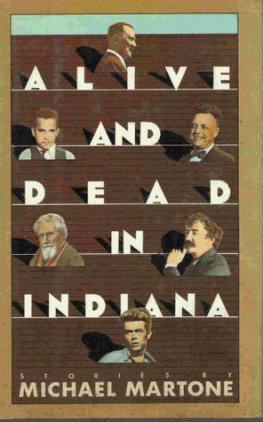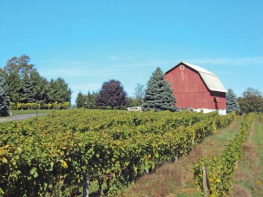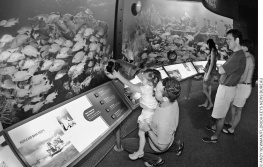Michael Martone
Racing in Place: Collages, Fragments, Postcards, Ruins
These are for
Susan Neville
11 miglior fabbro

I thank the editors of the books and magazines where these essays first appeared. "Racing in Place" was written for A Year in Place, edited by W. Scott Olsen and Bret Lott and published by the University of Utah Press, and was reprinted in Fourth Genre. "City Light and Power" first appeared in Fort Wayne magazine. "Fore" appeared in Alabama Literary journal, edited by Jay Lamar. "What I Want to Tell" was published by Michigan Quarterly Review, edited by Laurence Goldstein. "Going Up" was published by Stephanie G'Schwind in Colorado Review. "Still Life of Sidelines with Bob" was published in Notre Dame Review, edited by William O'Rourke. "My Father Has Been Turned into a Monstrous Vermin" appeared in the Seattle Review as "Mascots" and as "A Menagerie of Mascots" in In the Middle of the Middle West, an anthology edited by Becky Bradway. "Ephemera" was commissioned by Ninth Letter and Philip Graham. "Sympathetic Pregnancies" appeared in Scoot Over Skinny, edited by Donna Jarrell and Ira Sukrungruang. "Seven Dwarf Essays" was commissioned by Kate Bernheimer for her anthology Brothers & Beasts, published by Wayne State University Press and reprinted in Cream City Review. "Sixteen Postcards from Terra Incognita" appeared in PRISM international. "Views of My Glasses" was first published in Ninth Letter. "Thirteen Ways of Looking at the Moon Winx" was first published as "An Ode to the Moon Winx Lodge Sign" in Oxford American. And "On Being" appeared in a special edition of Denver Quarterly, edited by Paul Maliszewski.
Thanks to the quilting bee in Alabama-Sandy Huss, Robin Behn, Wendy Rawlings, Joel Brouwer, Joyelle McSweeney, Patti White, Kate Bernheimer, Philip Beidler, John Crowley, and all of my colleagues in the Indiana limestone-clad Morgan Hall. Praise be to all my students past and present. Paul Maliszewski, Tobin Anderson, Vince Standley, Linda Perla, Deb Unferth, Steve Fellner, Steve Featherstone, Robin Black, Diana Joseph, Sandy Jacobs, Jane Dupuis, Kim Kazemi, Peggy Shinner, Sara Jane Stoner, Jennie VerSteeg, Cynthia Reeves, and Allison Wade. Glory be to the correspondents who received the postcards. Sejal Shah, Brenda Mills, Adria Bernardi, Lea Powers, Pat Warrick, Jean Harper, Rikki Ducornet, Jay Brandon, Ted Bonar, Charlie Baxter, Lex Williford. And thanks be to those who've pieced these pieces together. Mike Wilkerson, Michael Rosen, Nancy Esposito, Monroe Engel, Ann Jones, Kathy Hall, Marilyn Sandidge, Melanie Rae Thou, Valerie Miner, Chris Leland and Osvaldo Sabino, Chris Riley and Mark Feldman, Joe Geha and Fern Kupfer, Steve Pett and Clare Cardinal. Valerie Berry used 30 Ethilon black monofilament nylon nonabsorbable surgical suture to tie things up. Marian Young, my secret agent, Stephen Barnett, and the folks at the press patched the book together. Sam and Nick worked the puzzle. And Theresa shored up all the rest.
In the Middle of Things: An Introduction or an Afterword


This book is a mess. Well, not this book, the one you are reading now, the finished product with its finished pages, its finished cover. A few weeks ago, I responded to the author's questionnaire, a marketing survey so extensive and detailed that you lose track of what you once thought you knew about your own book while writing catchy pitches for ad copy and sales meetings. I wrote addresses, too, of critics and reviewers who, by now, have or haven't written reviews about the book. Reviewers often don't even receive finished copies of the book, but bound galleys instead, which warn not to quote from this version because things are still uncorrected, unproofed, unfinished, and in flux. And Alison Lerner, in marketing, recently requested cover ideas she'd then forward to design and production and needed a new picture of me, as the one I had sent didn't have the digital oomph she needed for reproduction. My ideas for a cover were a collage of blimp and zeppelin photos or, maybe, a plate of one of the Gee's Bend quilts, long on tour but now making their way back home to Alabama. I don't know, now as I write this, what the cover actually is, nor any of the versions or mock-ups. You, the reader of this introduction, do know (in this other now, the now of your reading the finished book). And I don't know who they finally got to blurb the book, though I just sent a note of some names of people who might want to read these essays in typescript and e-mail a few sentences back to Athens. The flap copy needs to be written, telegraphic paragraphs the book reps can use to pitch to bookstore buyers sometime in the future. I haven't done it yet, but I will probably go up to Chicago in the fall to the Great Lakes Booksellers Association meeting and hang around the table manned by the Miller Brothers, the regional distributors for the press, promoting the finished product to the dwindling number of bookstore owners and managers in the hope that they will order a copy or two of the book that, right now as I write this, is in parts and pieces, unfinished and even unbegun, on disks and scrap paper in Athens, Tuscaloosa, and Fort Wayne. That all has yet to be done along with this introduction that is only as far along as this word I am typing right now. So the now of this book, the book that is (as I write this right now) a mess, is not the book of the now now, the moment now that you are reading this this.
But that's the way it always is. The process of book production is obscured, mystified, it seems, a lot by the complex nature of the actual making, but a little bit intentionally (on the part of authors, agents, and publishers) to give the work a sheen of magic, a gloss of spontaneity. You, reader, who admire books, share with the devotees of legislation and sausages the admonition that one shouldn't track the way laws, links, or books are being made. A book, especially, wants to appear parthenogenetic. And that's particularly funny as the publisher of this book is headquartered in a town named after the goddess who, as Zeus's afterthought, embodied forethought, fully armored and ready to rumble, sprang from some mythic migraine. We'd like to think a writer writes something someplace and the pages are sent off and after awhile a book springs forth, hot type and all, and appears on a shelf someplace. But buried there in the process is my early query letter to Nicole Mitchell, the press's director, and the negotiations with Andrew Berzanskis, the acquiring editor, who rounded up the anonymous readers-anonymous to me still-who wrote reports for the press's Board of Directors, who signed off on what was then a pile of loose paper with notations from Andrew that the title probably will be changed and the two brief essays will be scrapped and, oh yes, the introduction is to come, the author, in Alabama, having some difficulty writing it, not even sure the book needs an introduction and unsure what the introduction should say at this point. And the holidays are approaching, so that means that Andrew won't even have a contract until the first of the year and it, the contract, unwritten, will have to be vetted by my agent, Marian Young, who will attach her clause with her mailing address in New York, instructing that any money that the book produces will be sent first to her before it comes back to me, and she will make a good case that I receive more complimentary copies of the finished book when it is finished than the paltry number the boilerplate specifies. And I won't even go into the copyediting because I don't know at this point who will be editing this, though I hope it is Mindy Wilson, a freelance editor I worked with the last time and who was, ten years ago, my student at the University of Alabama. I directed her writing of her thesis, a book of stories, the first thesis I directed at Alabama. I went through the book peppering Mindy with questions as she now is (or soon will be) going through this book, tabbing her questions with bright-colored Post-it notes. But that is all in the future, though now, now that you are reading this, it is in the past.














